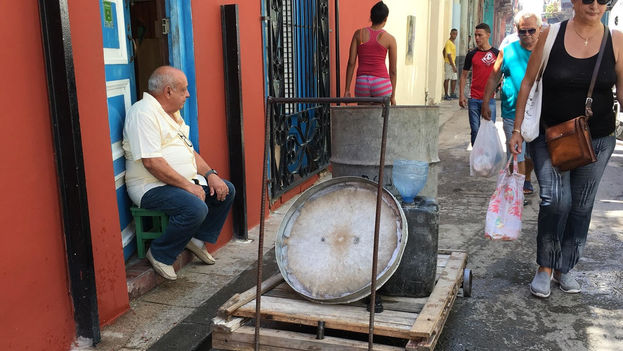
![]() 14ymedio, Havana, 2 June 2017 – The water supply pipe from the South Catchment area that suffered a rupture a week ago began to operate on a trial basis Thursday morning, according to a report by the Havana Water enterprise. Nevertheless, service has still not been re-established in all of the capital’s municipalities as 14ymedio was able to confirm.
14ymedio, Havana, 2 June 2017 – The water supply pipe from the South Catchment area that suffered a rupture a week ago began to operate on a trial basis Thursday morning, according to a report by the Havana Water enterprise. Nevertheless, service has still not been re-established in all of the capital’s municipalities as 14ymedio was able to confirm.
Three tanker trucks supplied water Thursday afternoon to the Tulipan Hotel which housed the deputies who attended the last special session of Parliament. The scene of trucks and people moving buckets or tanks was repeated in the streets and avenues of the capital’s most populated zones on Friday morning.
Industry authorities assured the official press that the connection of 1.2 kilometers of the first two lines of high density polyethylene was concluded in the stretch where the rupture occurred. But the replacement pipes have a smaller diameter and will only gradually allow the transfer of some 1,300 liters per second.
This volume is half that which flowed through the original conduit, built 60 years ago and whose central, 36-kilometer line is composed of pipes two meters in diameter.
During the first six days after the break, the number of those affected exceeded 800,000 people throughout the city. The price of water shot up on the black market, and a medium-sized “pipe” doubled in price to more than 50 Cuban convertible pesos (CUC).
As of a week ago, more than one hundred construction workers from the Institute of National Water Resources and from the Ministry of Construction worked in order to repair the breakdown, which affected 50 meters of the South Catchment area in the Quivican municipality of Mayabeque province. It is estimated that the investment to repair the pipes is about five million Cuban pesos (roughly 200,000 CUC/US$).
The tests are targeted to fill the Palatino central tanks in the neighborhood of Cerro, which supplies water to the municipalities of Habana Vieja, Centro Habana, Plaza de la Revolucion, Cerro, Diez de Octubre and part of Boyeros.
Translated by Mary Lou Keel
